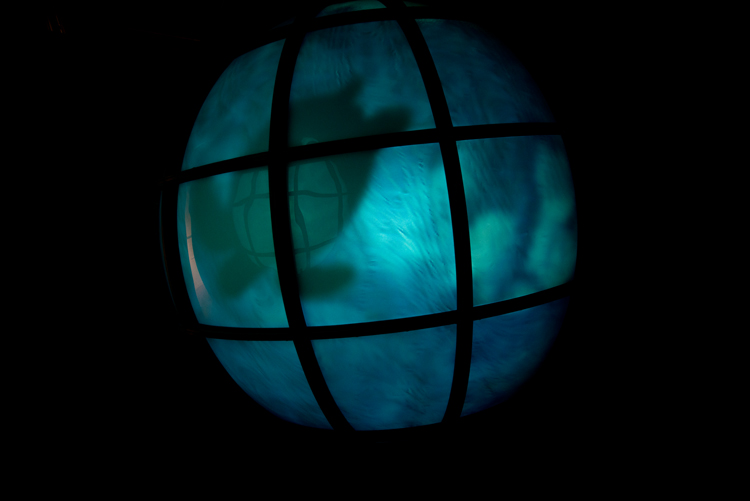
installed at the Mint Museum, Charlotte, NC
2014
wood, glass, steel, projection coating, paint, two projectors, speakers and CPUs
SEA to SEE is a unique installation, designed to accompany the Mint Museum’s upcoming exhibition “Connecting the World: The Panama Canal at 100.” As an option to making an additional artwork regarding the manmade canal, the artist seeks to create a work that focuses on the oceans it connects. Instead of expressing the sea in symbolic form, the effort is to create two unique cinematic portraits, one of the Atlantic and one of the Pacific Oceans, utilizing animated visualization of oceanographic data. Because the research is vast and diversified, the artist is creating a format for creativity and collaboration, looking to engage scientists/historians to work with him and to have his/her inquiry, or area of expertise, developed into a unique film. The challenge is to translate the research visually and to render it as a moving current on the screen where information becomes a cinematic ribbon of oceanographic data. Ultimately, many films will be made, and once collected they will be layered/edited together to create composite portraits of the Atlantic and Pacific Oceans.
The films will be witnessed by museum audiences standing before two massive hemispherical glass projection screens facing each other in the installation. Designed with the skeletal frames of the Panamanian Miraflores lock doors in mind, they will appear as 12ft.-in-diameter bulges holding back the Atlantic and Pacific waters that lie on opposite sides of the historic canal. The glass panes will sandwich translucent plastic debris and sprays of crude oil (a reference to the islands of plastic waste and oil spills) to create a surface for back-projected films that loop in 10-minute sequences.
The information presented will be based on research on the transformation of the oceans during the 100 years since the building of the canal, quite possibly conveying the impact of human constructions on the ecology of the oceans. The data visualization will result in digitally-created films, layered upon each other as an “aquafied articulation” of historical, cartological, and factual understanding of the oceans.
Examples of translating One Hundred Years of Scientific Citings:
A 10-minute sound track is being made based on a century of historical whale populations and ship traffic particular to each ocean. Each 6 seconds (one year) will present the volume of noise calibrated to whale populations and the number of ocean going vessels – sounds of ships sailing, powered by steam, and diesel.
One component will be the darkening and lightening of blue hues reflecting depths from place to place created by traversing at significant latitude lines along each ocean floor, (e.g. Tropic of Cancer/Capricorn, Equator). This will give a geographical signature based on color.
Another layer of imagery could be based on movement along the coast of landmasses using the frequency of bubbles to represent oxygen-rich areas with a marked decrease of bubbles when passing through dead zones that are the result of oxygen depletion from human industry.
A compilation of thousands of existing, archival illustrations of zooplankton and phytoplankton, activated by flash animation, float by on the opposing viewing screens. At the same time, “ghosts” of endangered or extinct species, seen in a unique color or light, appear and disappear among the living.
Fade into white: a project film based on the many conditions that provoke coral bleaching and the death of coral ecosystems.
The individual layers of the film can be added to and subtracted from, as new data refutes or augments existing preconceptions. This process can allow the films to grow with different and specific fields of oceanographic research being mixed into this cinematic sea. Rather than projecting a predictable outcome, this project’s final look is not known and, like the Panama Canal itself, the film is engineered in stages.
The artist seeks a creative partnership with scientists, students (in both science and art) and research universities to take on and reformat individual scientific investigations into data, to make independent films that can be part of this streaming informational compilation, SEA to SEE. The artist will work closely with any collaborators.



Collaborators:
Design consultants:
Christopher Beorkrem
Steven Plaxco
Construction:
Severn Eaton
Maria Perry Borghoff
Ann Glick
Jeff Crawford
Barron Brown
Helen Nagge
David Mays
Atlantic and Pacific Film/Sound:
Ben Premeaux
Jason Hausman
Eric Robel
Amber Frid Jimenez
Robin Starbuck
Jon Goldman
Gabriel Seth Koch
Data sources:
Jesse Varner (map visualization), NOAA National Geophysical Data Center and GEBCO, the Natural Earth project
Emelia Anne DeForce, PhD Microbio ecologist, MO BIO Laboratories
Claude J. Frankignoul, Woods Hole Oceanographic Institution
Henry Carson, Washington State Department of Fish and Wildlife
Erik Zettler, Ph.D., Professor, Oceanography Associate Dean for Institutional Relations and Research, Sea Education Association